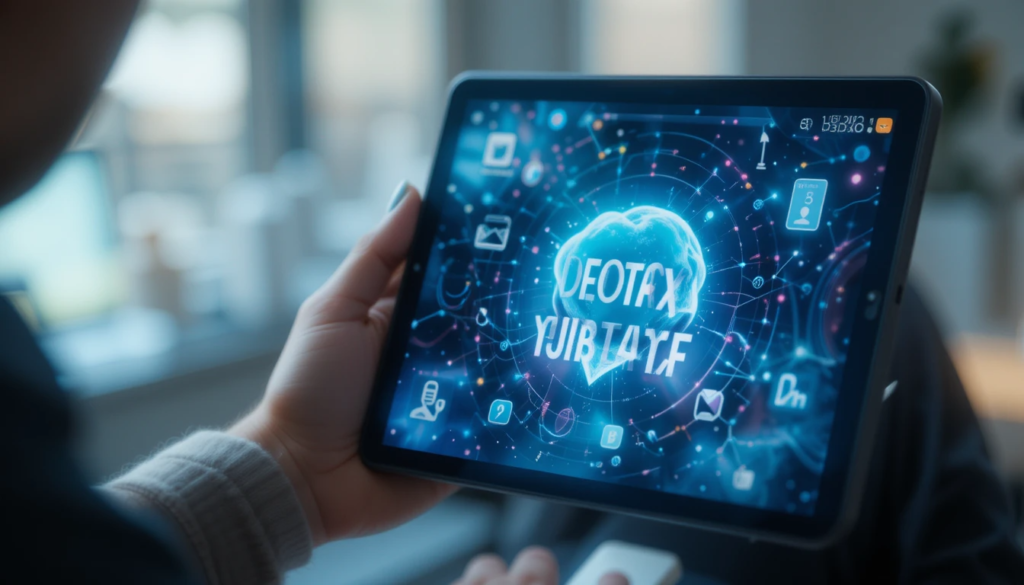In today’s world, technology is deeply integrated into our lives, with smartphones, social media, and digital devices keeping us connected around the clock. While this has its advantages, it also comes with its own set of challenges. The constant stream of notifications, emails, and social media updates can lead to increased stress, anxiety, and mental fatigue. This is where a digital detox comes into play. Unplugging from technology for a certain period of time can provide numerous benefits for both your mental and physical well-being. In this article, we’ll explore how a digital detox can reduce stress and provide practical tips for incorporating this powerful practice into your life.
What is a Digital Detox?
A digital detox refers to a period during which a person disconnects from their digital devices and technology, including smartphones, computers, and social media platforms. The goal is to take a break from the constant flow of information, allowing your mind to rest, recharge, and focus on the present moment without distractions. While the length of a digital detox can vary—from a few hours to several days or even weeks—the core idea is to consciously disconnect from the digital world to improve mental health and reduce stress.
How Digital Devices Contribute to Stress
Before we dive into how a digital detox can help alleviate stress, it’s important to understand the ways in which digital devices contribute to stress in the first place. Some of the most significant ways technology impacts stress include:
- Information Overload: We are constantly bombarded with information through emails, news apps, social media, and notifications. This constant influx of data can overwhelm our brains, leading to anxiety and mental fatigue.
- Social Media Stress: Platforms like Instagram, Facebook, and Twitter often present idealized versions of life, which can lead to comparison and feelings of inadequacy. Constantly checking social media can trigger stress and anxiety about our own lives, relationships, and appearance.
- Work-Life Balance Challenges: With the rise of smartphones and emails, it’s difficult to fully disconnect from work. The pressure to respond to work-related messages at all hours of the day can cause stress and disrupt personal time.
- FOMO (Fear of Missing Out): The constant updates on what others are doing—whether it’s on social media or through group chats—can make us feel like we’re missing out on important events, experiences, or social connections, leading to stress and feelings of inadequacy.
- Sleep Disruptions: Using digital devices late at night, especially before bed, can interfere with sleep. The blue light emitted by screens suppresses the production of melatonin, a hormone that regulates sleep, making it harder to fall asleep and leading to sleep deprivation, which can increase stress.
- Constant Notifications: The ping of a new email, text message, or social media notification can create a feeling of urgency and anxiety. Constantly checking these notifications can make it difficult to focus, relax, and stay present in the moment.
The Benefits of a Digital Detox
Now that we understand how digital devices contribute to stress, let’s take a look at the numerous benefits of taking a digital detox:
- Reduced Stress and Anxiety: Disconnecting from the digital world gives you the opportunity to recharge and reset your mind. With fewer notifications, emails, and updates to respond to, your stress levels naturally decrease.
- Improved Sleep Quality: By unplugging from technology, especially before bed, you can reduce the negative impact of blue light on your sleep cycle. This leads to better sleep quality, which in turn reduces stress and helps you feel more energized during the day.
- Enhanced Focus and Productivity: Without the constant distractions of digital devices, you can focus better on tasks at hand. A digital detox allows you to become more present and mindful in your daily activities, which enhances productivity and reduces stress related to unfinished tasks or multitasking.
- Better Relationships: A digital detox allows you to reconnect with the people around you, whether it’s spending quality time with family, friends, or loved ones. By unplugging from technology, you can engage in more meaningful, face-to-face interactions, which are essential for maintaining healthy relationships.
- Increased Mindfulness and Presence: A digital detox encourages you to be more mindful and present in the moment. Without constant digital distractions, you can better appreciate the world around you, engage in hobbies, and cultivate a sense of peace and relaxation.
- Improved Mental Clarity: Taking a break from digital devices allows your mind to rest and refresh. This mental clarity can help reduce feelings of overwhelm and provide a sense of calm and well-being.
- Enhanced Creativity: Stepping away from technology gives your brain the space to think creatively. Without the constant influence of digital media, you can tap into your own thoughts, ideas, and imagination, which can boost creativity and reduce mental fatigue.
How to Do a Digital Detox
A successful digital detox doesn’t require you to completely disconnect from the digital world. Instead, it involves setting boundaries and making intentional choices to reduce your screen time and limit your exposure to digital stimuli. Here are some practical tips for incorporating a digital detox into your life:
1. Set Time Limits on Device Use
One of the easiest ways to start a digital detox is by setting time limits on how much time you spend on your devices. You can use screen time tracking apps to monitor your usage and identify areas where you may be spending too much time on your phone or computer.
Start by setting specific time limits for activities such as social media browsing, checking emails, or watching TV. Gradually reduce the amount of time you spend on your devices each day and replace it with more mindful activities, such as reading, exercising, or spending time outdoors.
2. Schedule Tech-Free Times During the Day
Designate certain periods of the day when you will completely unplug from digital devices. For example, you might decide to avoid screens during meals, before bed, or when spending time with family and friends. Use this time to engage in activities that don’t involve technology, such as journaling, practicing mindfulness, or enjoying a hobby.
3. Create a Digital-Free Zone
Create a designated space in your home where digital devices are not allowed. This could be the bedroom, dining room, or living room. By limiting your use of technology in specific areas, you can reduce the temptation to check your phone or computer during moments of relaxation.
4. Turn Off Notifications
Constant notifications can be a major source of stress and distraction. Turn off non-essential notifications for apps like social media, email, and news. This will help reduce the feeling of urgency that comes with constantly checking your phone and allow you to be more present in the moment.
5. Unsubscribe and Declutter Your Digital Life
Over time, our digital lives can become cluttered with unnecessary emails, subscriptions, and apps. Take time to declutter your digital space by unsubscribing from unwanted emails, deleting apps that you no longer use, and organizing your digital files. This will help reduce the overwhelming feeling that comes with a cluttered inbox and notifications.
6. Practice Mindfulness and Meditation
Incorporating mindfulness practices, such as meditation or deep breathing, during your digital detox can help you relax and focus. Meditation can help clear your mind, reduce stress, and improve overall well-being. Set aside a few minutes each day to meditate, or practice deep breathing exercises to help calm your mind and reduce the urge to check your devices.
7. Take a Full Day or Weekend Off
For a more intensive digital detox, consider taking a full day or weekend off from technology. This could involve a weekend getaway without any digital devices or simply spending a day at home without screens. Use this time to reconnect with nature, engage in offline activities, and relax without the pressure of constant digital distractions.
Overcoming Challenges During a Digital Detox
While a digital detox can be highly beneficial, it can also be challenging. Many people find it difficult to disconnect from their devices, especially in a world where technology is constantly present. Here are some tips to help you overcome common challenges during a digital detox:
- FOMO (Fear of Missing Out): It’s natural to feel like you’re missing out on something when you disconnect from digital media. However, remind yourself that taking a break from technology will benefit your mental health in the long run.
- Urgent Work Commitments: If work-related emails or calls are urgent, set clear boundaries by scheduling specific times when you’ll check your devices. Communicate with colleagues or clients about your digital detox and let them know when you’ll be available to respond.
- Social Pressure: If you feel pressured to stay connected for social reasons, remind yourself that taking a break from digital devices is not only beneficial for you, but also for your relationships. Be open with your friends and family about your intentions, and they’ll likely support you in your efforts.
Conclusion
A digital detox can be a powerful tool for reducing stress and improving mental well-being. By disconnecting from technology, you give yourself the opportunity to recharge, focus, and reconnect with the present moment. Whether it’s a few hours, a full day, or an extended period of time, taking a break from the constant barrage of digital stimuli can help you reduce stress, improve sleep quality, and enhance your overall health.
Incorporating a digital detox into your routine can be challenging, but the benefits far outweigh the initial discomfort. Start small, set boundaries, and gradually unplug from your devices to experience the positive impact on your stress levels and mental clarity.


